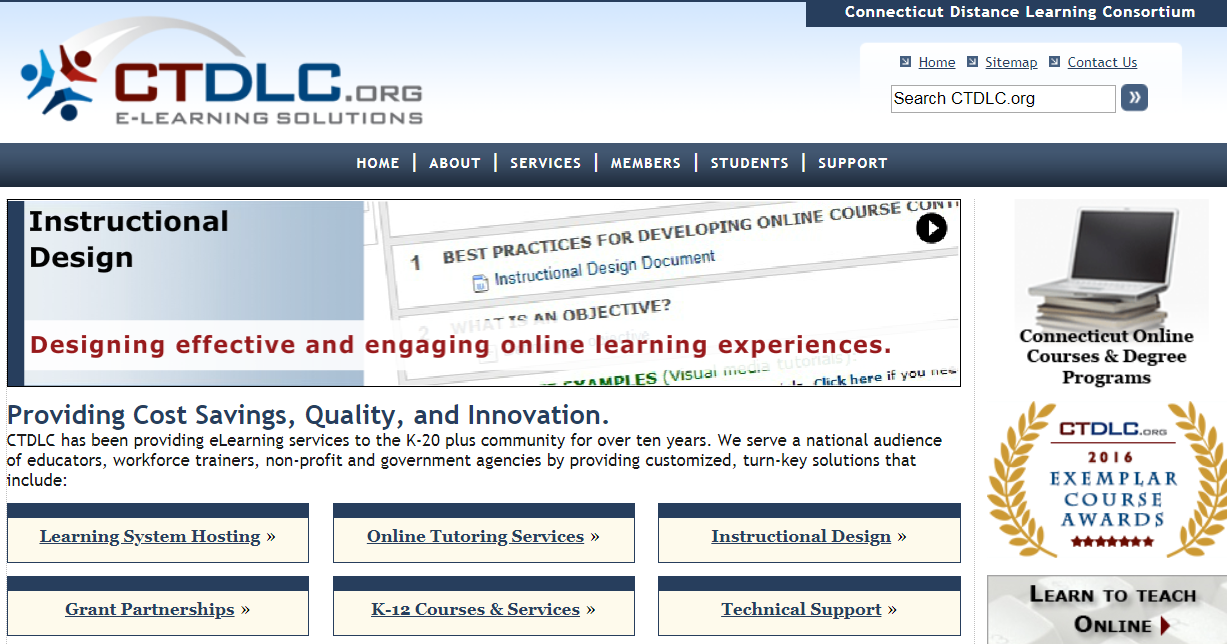A Consortium Closes. Wondering Why? And Why I Will Miss It.
Published by: WCET | 6/29/2018
Tags: Collaboration/Community, Consortia, Partnership, Student Success, Teaching
Published by: WCET | 6/29/2018
Tags: Collaboration/Community, Consortia, Partnership, Student Success, Teaching
As recently as April, I cited the Connecticut Distance Learning Consortium (CTDLC) as a stellar example of institutions coming together to accomplish more in partnership than they could on their own.
Shortly thereafter, it was announced that CTDLC is closing this summer. I’m very sad. As I did with the demise of the University of Texas TeleCampus, I do worry that the “wrong conclusions” may have led to this decision and may result from others observing this closure.
In many ways they were like other consortia that provided its member campuses with services that improved the efficiency and scale of services for distance education, online learning, and educational technologies both on- and off-campus. There’s a more complete description of their services at the end of this post, but they included:

Where they excelled was in their entrepreneurial spirit, necessitated by the very small appropriation provided by the state. From the beginning, they had to generate much of their own funding. In a survey that we conducted about how consortia were funded in 2008, most respondents had only one or two sources of income…typically appropriations and/or dues. CTDLC was an outlier in also having grant funds, services for sale, and gained income from services sold to non-members. They had to be responsive to the market to continue.
Some other ways in which they differ from most consortia:
I have made many good friends on the CTDLC staff. Ed Klonoski started the collaborative back in 1998 and brought to it the entrepreneurial vibe that was its hallmark. When Ed became President of Charter Oak State College, the indomitable Diane Goldsmith was a ready successor. When she left, Kevin Corcoran took over and was as gracious and thoughtful of a leader as you could find. All have served in WCET leadership positions and I respect each of them and their colleagues whom I’ve not named here.

Falling enrollments and a huge impact on the state’s treasury from the federal tax cuts. Higher education in Connecticut is in bad shape. There’s no disputing that.
An Inside Higher Ed article provided some background on the reasoning behind the closure. I very much respect Mark Lieberman who wrote the article, but I let him know that I disagreed with many of the conclusions of those whom he quoted.
Pressure was placed on Charter Oak State College’s (which has fiscal responsibility over CTDLC) President, Ed Klonoski, to force the closure. Numbers presented to his Board made it appear as if CTDLC would not cover its own budget. I’m sure that the fact that they College overall was deeply in the red and facing its own fiscal challenges complicated the decision-making.
I feel deeply for Ed Klonoski as he had to be the one to close the operation he began two decades ago. He had no winning options placed in front of him.
While I have not examined every document, I still come up with questions that make me wonder if the decision was the best one for the state, or for consortia, as a concept.
Remember how I said CTDLC was the most entrepreneurial consortium? Most public consortia receive the bulk of their funding from appropriations. Only a few public consortia also include dues, which are the main source of funding for consortia that serve non-profit institutions. CTDLC raised one-third to one-half of its budget from its diverse revenue streams.
It seems like the fact that it did not cover all of its expenditures on its own was used against it. But, the purpose of a consortium is to have a central expenditure that saves time and money for all.
Where is the analysis of what it will cost the state’s institutions to end these services?
Their decision does not seem to take into account the new expenditures that institutions will need to make to replace CTDLC’s services. Will they do it efficiently? Will it cost less? Doubtful. How will the state save money if most of the staff gets reassigned, which is what appears to be happening to them? Don’t know.
When the University of Texas TeleCampus closed down they had to reinvent a new organization to assume many of their services. Where was the savings in that move?
Speaking of the University of Texas TeleCampus, I wrote an editorial for Inside Higher Ed regarding its closing back in 2010 titled “Drawing the Wrong Conclusions.” I repeat my final paragraphs here as I’m experiencing déjà vu. You could swap out “TeleCampus” for “CTDLC” and it still works:
“What lessons can be drawn? Many theories on the TeleCampus closure have been offered, including those around financial, leadership and organizational dynamics. My sincere hope is that others do not draw the wrong conclusions from this experience in assessing the worth of their own consortium. Consortiums are unique entities. While general principles may apply, their value can be judged only in each unique, local environment. The local landscape contains political, financial and historical barriers and opportunities that do not translate well from place to place.”
“Am I saying that we cannot learn anything from this experience? No. There will be much to learn. WCET’s eLearning Consortia Common Interest Group includes leaders from many consortiums in the United States and Canada. This decision renewed efforts within the group to examine consortium success factors and to identify practices that do (or do not) work. Keep watching for developments.”
“In the end, why is the University of Texas System closing its TeleCampus? I remain perplexed, and I hesitate to guess, as I will probably draw the wrong conclusions.”
The WCET Consortia Group conducted a survey of consortia operations and we will release the results soon. We will also be hosting a workshop preconference at the WCET Annual Meeting and this closure will certainly be something we discuss.
I will miss CTDLC because they were so innovative and entrepreneurial. Higher education is in a transitional moment whether it wants to acknowledge it or not. We need collaborative new solutions to succeed.
Finally, kudos to the CTDLC staff and good luck in your new roles that you will be assuming. I join with many others who appreciate your work.
-Russ
CTDLC Services
Learning System Hosting – “Our Hosted service provides the necessary hardware and staffing for your eLearning needs. We provide 365/24/7 monitoring of your applications. We couple this service with our Support Center services to handle any questions or problems from your user community.” They also had consulting and custom development offerings.
Online Tutoring Services – “It is a virtual program and model where institutions partner to share their tutors and expertise across one dynamic, interactive platform, providing access for students to a wide range of tutoring services and subjects across one shared schedule.” They won the 2007 WCET WOW Award for developing this service.
Instructional Design – “Our Instructional Design (ID) team performs a full needs analysis to make sure your learning objectives are met. They provide complete design and development of your online courses.” They also provided a faculty development events, course audit, and consulting services.”
Grant Partnerships – “By creating partnerships with other institutions, we create strong proposals to attract grant funding. We have been awarded federal, regional, and state grants for projects such as those that resulted in our eTutoring Collaboration, our ePortfolio platform, and our research into the technical skills of today’s students.”
K-12 Courses and Services – “Our K12 Technical Services including hosting, instructional design, and support of various eLearning applications.” They also provide students in adult education programs online courses and support.
Technical Support – “Our Support team provides personalized and managed technical and instructional support via phone, email, web-based ticketing system and support portal, as well as virtual meeting space technologies for your students, instructors, and staff.” This included outsourcing and co-sourcing.
__

Russell Poulin
Director, Policy & Analysis
WCET – WICHE Cooperative for Educational Technologies
rpoulin@wiche.edu | @russpoulin
